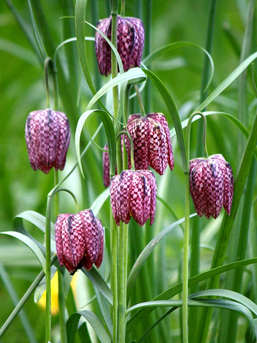The Snakeshead Fritillary (Fritillaria meleagris)
"The fritillary looks like something exceedingly choice and delicate and expensive, which ought to spring from a pan in a hothouse, rather than share the fresh grass with buttercups and cowslips.” So said Edwardian gardener and writer Vita Sackville-West, and how right she was!
A little Moroccan lantern, dangling from an elegant green hook – who could fail to be both charmed and wowed by the exotic-looking Fritillaria meleagris? The sulky maiden, leper’s lily, frog’s cup, guinea-hen flower, or the snakeshead fritillary, as we know it today, this beauty is a small marvel of nature.
At about Easter time, the young flower bud - wrapped tightly by its narrow leaves - pushes its way up, the nose of a small snake appearing in the meadow or the garden border (it is really at this stage that it looks most like its common name). As the stem lengthens, it arcs over elegantly to ensure that the all-important nectaries within the nodding bells are kept protected from the rain. After pollination, the stems straighten back up again and lengthen so that the seed pod is held high enough to scatter its seeds as far as it can.
The extraordinary chequered pattern on its petals - like a slightly irregular chessboard - draws gasps, but it turns out we can rely on the late great code-breaker Alan Turing for an explanation! In 1952 Turing wrote an article explaining that this sort of pattern (actually not uncommon in nature) comes from the interaction of two chemicals: an activator and an inhibitor. The two work together and against each other, and the blobs of colour are repelled by their opposite.
The snakeshead fritillary is a small beauty, flowering at a height of about 15-20 cms, but its modest size belies its enormous amount of DNA. This wee plant contains more than 15 times as much as humans do, and if unravelled, its genome would stretch over 30 metres. That’s some snake!
*** Fritillaria meleagris is now available from our plant nursery, alongside many other little pots of Spring treasures. Priced at £2 each, or 3 for £5, what better way to kick start your Spring?! We are open Monday to Friday, 9-4pm, and have a tearoom on site selling delicious home-made quiches, scones, cakes etc.
"The fritillary looks like something exceedingly choice and delicate and expensive, which ought to spring from a pan in a hothouse, rather than share the fresh grass with buttercups and cowslips.” So said Edwardian gardener and writer Vita Sackville-West, and how right she was!
A little Moroccan lantern, dangling from an elegant green hook – who could fail to be both charmed and wowed by the exotic-looking Fritillaria meleagris? The sulky maiden, leper’s lily, frog’s cup, guinea-hen flower, or the snakeshead fritillary, as we know it today, this beauty is a small marvel of nature.
At about Easter time, the young flower bud - wrapped tightly by its narrow leaves - pushes its way up, the nose of a small snake appearing in the meadow or the garden border (it is really at this stage that it looks most like its common name). As the stem lengthens, it arcs over elegantly to ensure that the all-important nectaries within the nodding bells are kept protected from the rain. After pollination, the stems straighten back up again and lengthen so that the seed pod is held high enough to scatter its seeds as far as it can.
The extraordinary chequered pattern on its petals - like a slightly irregular chessboard - draws gasps, but it turns out we can rely on the late great code-breaker Alan Turing for an explanation! In 1952 Turing wrote an article explaining that this sort of pattern (actually not uncommon in nature) comes from the interaction of two chemicals: an activator and an inhibitor. The two work together and against each other, and the blobs of colour are repelled by their opposite.
The snakeshead fritillary is a small beauty, flowering at a height of about 15-20 cms, but its modest size belies its enormous amount of DNA. This wee plant contains more than 15 times as much as humans do, and if unravelled, its genome would stretch over 30 metres. That’s some snake!
*** Fritillaria meleagris is now available from our plant nursery, alongside many other little pots of Spring treasures. Priced at £2 each, or 3 for £5, what better way to kick start your Spring?! We are open Monday to Friday, 9-4pm, and have a tearoom on site selling delicious home-made quiches, scones, cakes etc.


 RSS Feed
RSS Feed